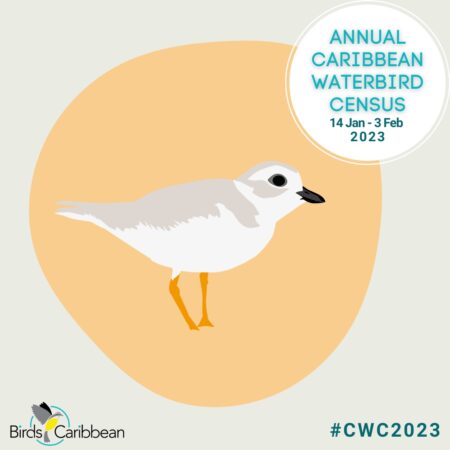
This year we have featured seven waterbirds in our Caribbean Water Census graphic! Find out more about each of these beautiful birds in our blog posts and on social media.
The Caribbean Waterbird Census starts today! And our featured bird is the small, round, sand-colored Piping Plover.
These plump shorebirds have ‘stubby’ bills that are orange at the base with a black tip in summer and completely black in winter. When they are breeding they have a black band all or part of the way around their neck and breast. In the autumn and winter some birds will completely lose this band. Piping Plovers are white below and their ‘dry sand’ colored plumage above can make them tricky to spot. Don’t forget to look out for their orange legs! You can listen out for their distinctive two-note “pee-too” whistling call to help you locate them.
Listed as “Near Threatened” by the IUCN the small global Piping Plover population only breeds in restricted areas of North America. Developments on beaches and lake shores mean Piping Plovers have lost some of their breeding habitat. This means Piping Plovers are now far less common than they used to be. Nesting areas on beaches are now often protected from disturbance to try to help the population increase.
Piping Plovers migrate south in fall and some birds spend their winter in the Caribbean. Here they can often be found on sand flats and beaches, but can also be found on muddy areas, in mangroves and on rocky shorelines. This year we are asking for people to make a special effort to look for these small plovers during our CWC count period. To take part you can check our blog post for some plover ID advice and resources as well as some fantastic survey tips!
CWC 2023 starts on Saturday January 14th and runs to Saturday February 4th.
Click here or detailed instructions and free downloadable resources to help you make the most of your CWC count.
CWC 2023 starts on Saturday January 14th and runs through Friday February 3rd. See below for detailed instructions and free downloadable resources to help you make the most of your waterbird counts and don’t forget to keep an eye out for Piping Plovers!
Find out more about Piping Plovers

![PIPLFW[YA]andFL[8P]CINSnorthbeach-Patrick-Leary Banded Piping Plovers](https://i0.wp.com/www.birdscaribbean.org/wp-content/uploads/2023/01/PIPLFWYAandFL8PCINSnorthbeach-Patrick-Leary.jpg?w=400&h=287&ssl=1)






